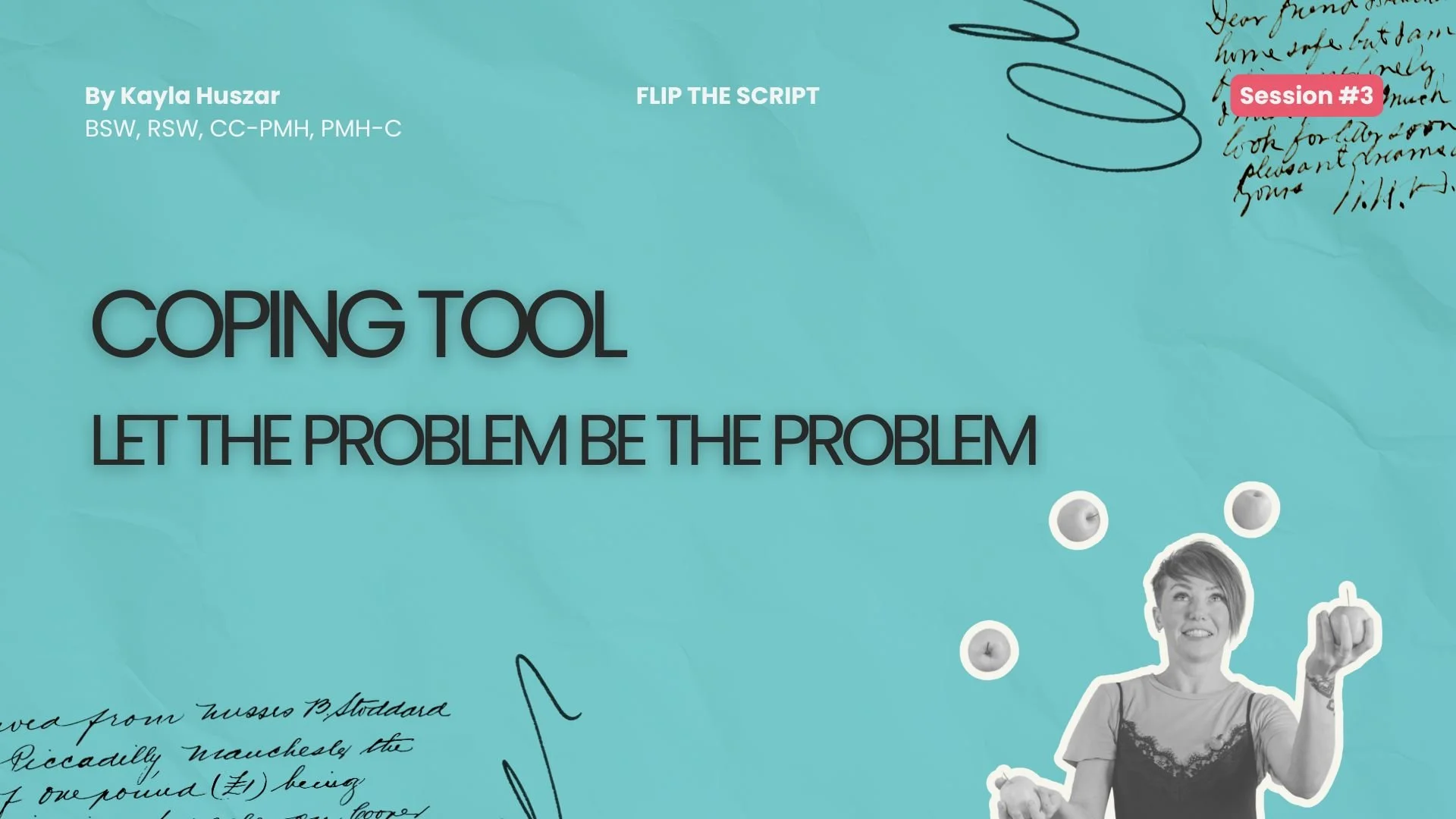#3 COPING TOOL - Let The Problem be the Problem
Self-compassion coping tool for moms who are tired of feeling like the villain in their own story.
Inspired by Olivia Scobie
💭 But First, a Soft Reality Check:
If you’ve ever caught yourself thinking, “Maybe I am the problem,” after wiping down the counter, wrangling a tantrum, and hiding in the bathroom with your phone and a stack of parenting experts…
You’re not alone.
When we’re overwhelmed, overstimulated, and emotionally fried, our brains reach for someone to blame. And usually? That finger points to you, your partner, or your kids.
This tool gives you a way out of that spiral.
✨ The Reframe:
Try this: Think of a problem you’re currently having.
It could be the unfair division of labour, your kids’ behaviour, the moving routine, or your partner’s work hours.
Now ask yourself:
“If I’m not the problem… and they’re not the problem… then what is the actual problem?”
This isn’t about ignoring reality—it’s about creating space to see it more clearly.
Because when we let the problem be the problem, we stop making villains out of the people we love (Including ourselves.)
🧠 Why This Works:
When used regularly, this tool shifts your nervous system from:
❌ self-blame ❌ internalized failure ❌ reactive spiraling
To:
✅ clarity ✅ emotional regulation ✅ grounded problem-solving
And it reinforces this truth: You are not the problem.
You are a human inside a broken, demanding system.
And while we can’t always wait for the system to change… we can build tools of resilience that help us live softer inside it.
🖌 The Coping Tool: Let’s Name It
Before we name the problem, let’s explore how it’s showing up for you:
💬 Ask Yourself:
What do I believe about this situation?
What does this “problem” feel like in my body?
If it had a shape, colour, or texture—what would it be?
What’s the story it keeps whispering to me?
Where did that story come from?
✍️ Try These Sentence Starters:
“The story I keep hearing in my head is…”
“If this problem had a voice, it would say…”
“If I believed it wasn’t my fault, I might see that…”
Remember you are not the problem and they are not the problem… Take your time.
You’re allowed to scribble, rant, cry, or sit quietly.
All of it counts.
📄 Then, Name the Problem:
Remember: If I'm not the problem and {they} aren't the problem... What is the actual problem?
Write it down clearly and directly.
Example: I'm I'm not the problem and my partner isn't the problem... The problem to be solved: We are not on the same page about consistent and fair discipline.
Now brainstorm a few possible ways to work toward resolving it—without assuming it’s your job to carry it alone.
🎨 Art Prompt 1: The Problem in the Room
Draw the actual issue that’s been showing up lately in your home or in your head.
Don’t draw people—draw the problem as an object, a monster, a thundercloud, a boulder, a sticky mess.
Label it. Externalize it.
Make it something you can actually look at.
🎨 Art Prompt 2: The Bridge
Now draw a bridge between where you are and where you want to be.
Ask yourself:
What’s under the bridge?
What’s keeping me stuck?
What do I need to get to the other side?
💡 Optional: Take a photo of your art and reflect in your journal or voice notes.
Or share it inside the Motherload group - it might help another mom feel less alone.
✍️ Bonus Journaling Prompt:
“If I let the problem be the problem, I would stop blaming ____, and start addressing ____.”
Let the sentence be a doorway. Walk through it slowly
⏱ Do This if You've Got 10 Minutes or Less:
Only have a few minutes between supper chaos and bedtime? Try this:
Take 3 deep breaths and ask: “What am I carrying that isn’t mine?”
Pick one sentence starter from above and write for 2 minutes - no censoring.
Draw a super quick sketch of the “problem” (stick figures, blobs, scribbles welcome).
Set a 5-minute timer and visualize the problem being resolved / no longer an issue.
So What Do You Do With This Now?
Stop assuming the story ends with you (or them) being the problem. Instead—pause.
You name what’s real.
You let the problem be the problem.
And from that place—not shame, not spiraling, not blame— you create a little space.
This week, I want you to practice this shift at least once.
When a dark or twisty thought starts whispering, “You’re the problem,” I want you to whisper back: “Maybe not. But I wanna find out what is” Then reach for your art. Or your journal. Or just the smallest thread of curiosity.
Because this isn’t about fixing yourself. It’s about freeing yourself.





